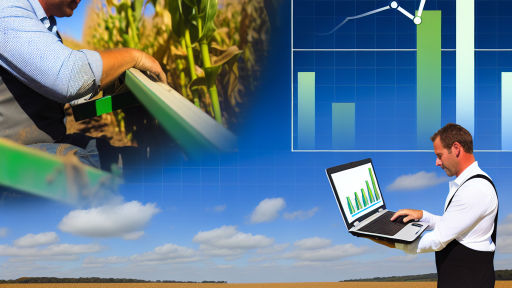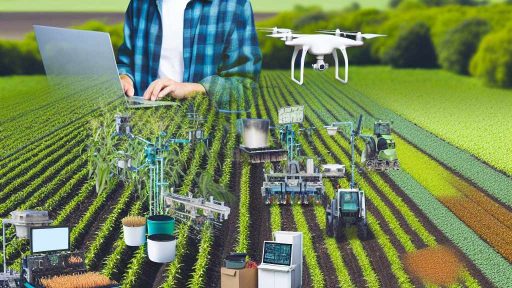Understanding the Role of Supply Chain Management in Farming
Defining Supply Chain Management
Supply chain management involves the coordination of production, procurement, and logistics.
This system helps farmers control every aspect of their operations.
Effectively managing these processes enhances productivity and reduces costs.
The Importance of Supply Chain Transparency
Transparency in the supply chain builds trust among stakeholders.
It allows for better decision-making and improves overall efficiency.
Additionally, transparency enables farmers to respond swiftly to market changes.
Key Components of an Effective Supply Chain
An effective supply chain has several critical components.
- Planning and forecasting to anticipate demands.
- Procurement strategies to source quality materials.
- Logistics management to ensure timely delivery.
- Quality control measures to maintain product standards.
Technological Innovations in Supply Chains
Technology plays a vital role in modern supply chain management.
Farmers utilize software for inventory management and data analysis.
Furthermore, technologies like blockchain enhance traceability and accountability.
Adopting these innovations leads to smarter operations and increased efficiency.
Collaboration Across the Supply Chain
Collaboration among suppliers, distributors, and retailers is essential.
This teamwork fosters a cohesive approach to problem-solving.
Implementing collaborative strategies enhances responsiveness to market fluctuations.
Measuring Success in Supply Chain Management
Measuring the effectiveness of supply chain management is crucial for continuous improvement.
Transform Your Agribusiness
Unlock your farm's potential with expert advice tailored to your needs. Get actionable steps that drive real results.
Get StartedFarmers should evaluate key performance indicators regularly.
Metrics such as delivery time, cost reduction, and customer satisfaction offer insights.
Using these metrics allows for data-driven decisions that enhance operations.
Key Components of an Effective Supply Chain in Agriculture
Understanding Supply Chain Dynamics
The supply chain in agriculture encompasses multiple processes.
These processes include production, storage, processing, and distribution.
First, it’s essential to understand each component fully.
This understanding fosters better coordination among stakeholders.
Collaboration Among Stakeholders
Effective communication among stakeholders enhances efficiency.
Farmers, distributors, and retailers must align their goals.
Regular meetings can facilitate the sharing of important information.
Collaborative efforts can lead to improved forecasting and planning.
Technology Integration
Integrating technology optimizes supply chain processes.
Farm management software can streamline operational tasks.
Additionally, data analytics can improve decision-making.
Farmers can benefit from using drones for field monitoring.
Inventory Management
Accurate inventory management reduces waste and costs.
Keeping track of supplies ensures resources are available when needed.
Implementing inventory tracking systems can enhance visibility.
This transparency can lead to better replenishment decisions.
Transportation Efficiency
Transportation plays a critical role in supply chain effectiveness.
Choosing the right logistics partners can improve delivery speed.
Maintaining vehicles and optimizing routes are essential for success.
Technology can assist in real-time tracking of shipments.
Sustainability Practices
Adopting sustainable practices boosts supply chain resilience.
Showcase Your Farming Business
Publish your professional farming services profile on our blog for a one-time fee of $200 and reach a dedicated audience of farmers and agribusiness owners.
Publish Your ProfileFarmers should focus on eco-friendly production methods.
This approach can reduce carbon footprints effectively.
Sustainable practices can attract environmentally conscious consumers.
Risk Management Strategies
Identifying potential risks is crucial for maintaining a stable supply chain.
Market fluctuations and weather events can impact agricultural output.
Farmers should develop contingency plans to address these challenges.
Diverse sourcing options can further mitigate risks involved.
Identifying Bottlenecks: Analyzing Farm Operations for Optimization
Understanding Bottlenecks
Bottlenecks occur when a specific stage slows down the overall process.
They often lead to increased costs and reduced efficiency.
Identifying these bottlenecks is crucial for optimizing farm operations.
Steps to Analyze Current Operations
Begin by mapping out all farm processes in detail.
Include planting, harvesting, and distribution stages in your analysis.
Next, gather data on production times and resource usage.
Use this data to spot areas where delays frequently occur.
Key Metrics to Consider
Focus on metrics such as output rates and cycle times.
Monitor resource allocation across different tasks and stages.
Evaluate equipment effectiveness to identify underperforming areas.
Engaging Farm Personnel
Involve farmworkers and management in the analysis process.
Gather their insights on perceived delays and issues.
Encourage open communication to uncover hidden challenges.
Implementing Changes
Once bottlenecks are identified, prioritize which to address first.
Consider adjustments to workflows or resource allocation.
Implement training programs to improve workforce efficiency.
Monitoring Results
After changes are made, monitor the results closely.
Gather feedback from staff on the effectiveness of the adjustments.
Continuously analyze the operation to identify new bottlenecks.
You Might Also Like: Budgeting Tips For Sustainable Farming Practices
Implementing Technology
The Impact of IoT and Data Analytics on Supply Chains
In recent years, technology has transformed agricultural supply chains significantly.
The Internet of Things (IoT) plays a crucial role in this transformation.
IoT devices collect real-time data from farms and supply chains.
These devices monitor conditions such as soil moisture, temperature, and crop health.
With this data, farmers can make informed decisions quickly.
They can optimize resource usage and enhance crop yields.
Real-Time Monitoring and Control
Real-time monitoring is a game-changer for farmers and supply chain managers.
Connected devices provide insights into operational efficiencies.
This capability allows for immediate responses to environmental changes.
For example, sensors can alert farmers to watering needs.
Consequently, this reduces water waste significantly.
Additionally, farmers can track inventory levels accurately.
Data Analytics and Decision Making
Data analytics complements IoT by interpreting vast amounts of data.
Showcase Your Farming Business
Publish your professional farming services profile on our blog for a one-time fee of $200 and reach a dedicated audience of farmers and agribusiness owners.
Publish Your ProfileAdvanced analytics identify patterns and trends that inform strategies.
For instance, predictive analytics can forecast crop yields.
These forecasts help farmers plan better for harvesting and selling their produce.
Furthermore, data analytics optimize transportation routes within supply chains.
This leads to reduced operational costs and faster delivery times.
Case Studies of Success
Several organizations have successfully implemented these technologies.
AgriTech Inc. utilized IoT devices to enhance their monitoring capabilities.
As a result, they increased their crop yield by 15% in one season.
Similarly, GreenFields Farms applied data analytics to inventory management.
They reduced excess inventory costs by nearly 20%.
These examples highlight the tangible benefits of technology adoption.
Find Out More: Maximizing Crop Yields While Minimizing Costs
Sustainable Practices: How Supply Chain Optimization Contributes to Environmental Stewardship
Reducing Waste and Improving Efficiency
Supply chain optimization significantly reduces waste in farming practices.
Farmers analyze their processes to identify areas of improvement.
This leads to a more efficient use of natural resources.
Moreover, efficient logistics minimize transportation emissions.
As a result, farms can operate with a smaller carbon footprint.
Enhancing Resource Management
Optimizing the supply chain enhances resource management in agriculture.
Farmers utilize precision agriculture technologies for better data collection.
These technologies allow for targeted use of water and fertilizers.
Consequently, this reduces chemical runoff into local ecosystems.
Additionally, it promotes healthier soil and water quality.
Encouraging Sustainable Partnerships
Supply chain optimization fosters sustainable partnerships among stakeholders.
Farmers collaborate with suppliers committed to environmentally friendly practices.
This alignment contributes to a more sustainable agricultural ecosystem.
Such partnerships enhance traceability and accountability for sustainability.
Ultimately, they create a community approach to environmental stewardship.
Promoting Circular Economy Practices
Effective supply chain management promotes circular economy principles.
Farmers can repurpose waste materials into useful resources.
For example, composting organic waste enriches soil health.
This reduces dependency on synthetic fertilizers.
Moreover, recycling waste creates opportunities for new products.
Measuring Environmental Impact
Continuous assessment within the supply chain highlights environmental impact.
Farmers track metrics to evaluate their sustainability efforts.
This practice supports informed decision-making for future strategies.
Furthermore, it engages consumers who value transparent sourcing.
Enhanced visibility builds trust among all stakeholders involved.
You Might Also Like: Investment Strategies To Sustainably Grow Your Farming Business

Collaboration with Suppliers
Building Strong Partnerships
Collaboration with suppliers improves overall farm efficiency.
Strong partnerships create mutual benefits for all parties involved.
Showcase Your Farming Business
Publish your professional farming services profile on our blog for a one-time fee of $200 and reach a dedicated audience of farmers and agribusiness owners.
Publish Your ProfileEffective communication fosters trust and transparency in operations.
Additionally, shared goals enhance long-term collaborations.
Identifying Key Suppliers
Recognizing key suppliers is crucial for operational success.
These partners usually provide essential resources and materials.
Moreover, evaluating supplier performance helps identify strengths and weaknesses.
Regular assessments build credibility and reliability in collaborations.
Creating Value Through Collaboration
Collaborative efforts can significantly reduce costs and improve quality.
Joint problem-solving leads to innovative solutions beneficial for all.
Furthermore, sharing insights on market trends enhances decision-making.
This approach ultimately increases farm profitability and sustainability.
Enhancing Logistics and Delivery Systems
Streamlined logistics improve the efficiency of supply chains.
Working closely with suppliers facilitates timely deliveries and reduces delays.
In addition, advanced tracking systems help monitor shipments actively.
Consistent updates keep all stakeholders informed and engaged.
Implementing Technology Solutions
Utilizing technology enhances collaboration with suppliers.
Digital platforms simplify communication and data sharing between parties.
Moreover, predictive analytics can forecast supply needs efficiently.
Investing in technological solutions optimizes operations and reduces waste.
See Related Content: Networking Strategies for Agribusiness Growth
Case Studies: Successful Supply Chain Transformations in Modern Agriculture
Overview of Transformative Cases
Several farms have embraced supply chain optimization effectively.
These transformations lead to enhanced productivity and reduced waste.
We will explore notable case studies highlighting these success stories.
Green Fields Farm
Green Fields Farm implemented a new inventory management system.
This system replaced their outdated manual tracking methods.
As a result, they minimized errors in order fulfillment.
Moreover, the farm improved its forecasting accuracy significantly.
Impact on Efficiency
With the new system, Green Fields cut processing time by 30%.
The farm reported a 20% reduction in food spoilage.
Overall, these changes have boosted their bottom line.
Sunny Acres Produce
Sunny Acres Produce adopted vertical farming techniques.
This innovative approach optimized land use on limited acreage.
Additionally, the farm utilized hydroponics to conserve water.
Consequently, they achieved higher yields year-round.
Benefits of Vertical Farming
Sunny Acres increased production by 40% within the first year.
They also reduced operational costs due to less water usage.
This model promotes sustainability in urban agriculture.
Riverside Dairy
Riverside Dairy focused on streamlining its distribution network.
They collaborated with local transport companies for efficiency.
This partnership improved delivery times significantly.
Also, it minimized carbon footprints associated with transportation.
Showcase Your Farming Business
Publish your professional farming services profile on our blog for a one-time fee of $200 and reach a dedicated audience of farmers and agribusiness owners.
Publish Your ProfileResults from Optimization
After the changes, Riverside Dairy reported a 25% increase in deliveries.
Customer feedback highlighted satisfaction with faster deliveries.
Furthermore, the local community supported their sustainability efforts.
Transformative Impacts in Agriculture
These case studies illustrate the power of supply chain optimization.
Successful farms implement innovative practices to enhance efficiency.
These transformations benefit producers and consumers alike.
Evaluating Performance Metrics
Importance of Performance Metrics
Performance metrics play a crucial role in supply chain management.
They provide insights into operational efficiency and effectiveness.
Additionally, the right metrics can drive continuous improvement.
Farmers should assess their processes regularly for optimal results.
Key Performance Indicators for Farming Supply Chains
Identifying key performance indicators (KPIs) is essential.
Common KPIs include order fulfillment rates and delivery times.
Crop yield quality and inventory turnover rates also matter.
Incorporating these metrics can enhance decision-making processes.
Methodologies for Measuring Success
Various methodologies exist for tracking supply chain success.
Qualitative methods often focus on customer satisfaction.
Conversely, quantitative methods involve numerical data analysis.
Balancing both approaches yields comprehensive insights.
Regular Assessment and Adjustments
Regular assessment of metrics is vital for ongoing success.
Farms should review performance quarterly or annually.
Adjustments based on findings can lead to better outcomes.
Moreover, agility in operations remains key to responsiveness.
Integrating Technology in Performance Measurement
Technology enhances the measurement of performance metrics.
Utilizing software can automate tracking processes efficiently.
Data analytics tools provide deeper insights into trends.
Thus, farmers can make informed decisions based on accurate data.
Benchmarking Against Industry Standards
Benchmarking against industry standards is essential for evaluation.
Comparing performance with industry leaders reveals improvement areas.
Furthermore, it fosters a culture of excellence within operations.
Regular benchmarking helps maintain competitive advantage.
Additional Resources
USDA Agri-Food Supply Chain Assessment: Program and Policy …
FTI Consulting Enhances Food, Agriculture & Beverage Offering with …




